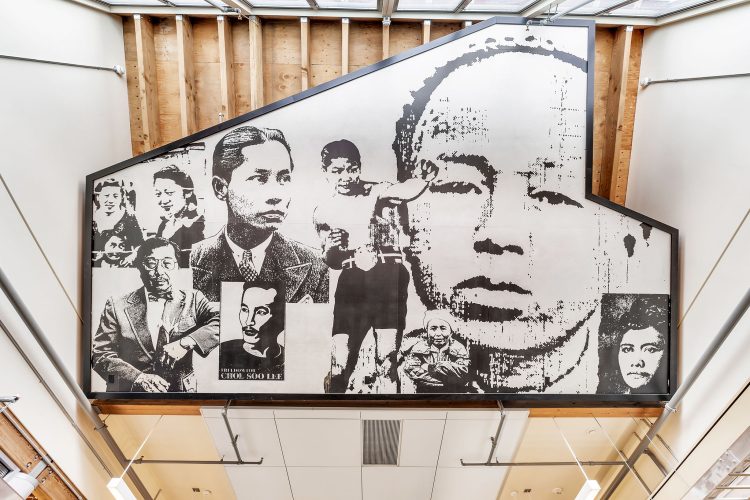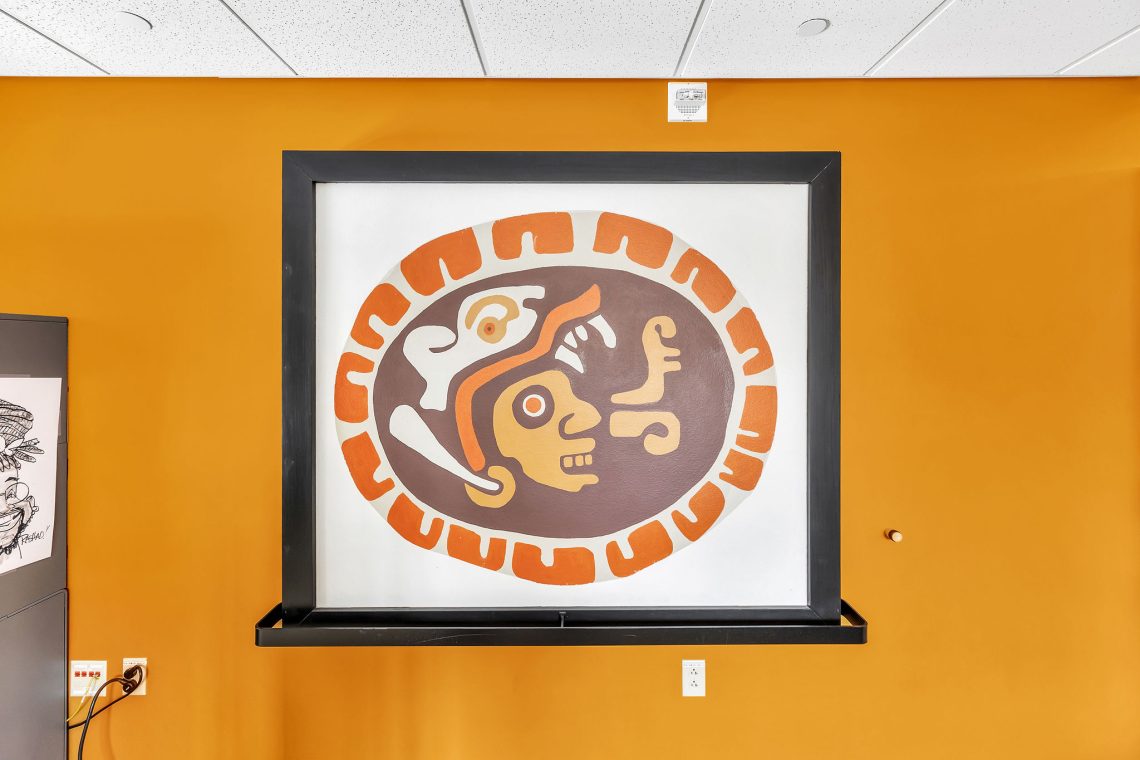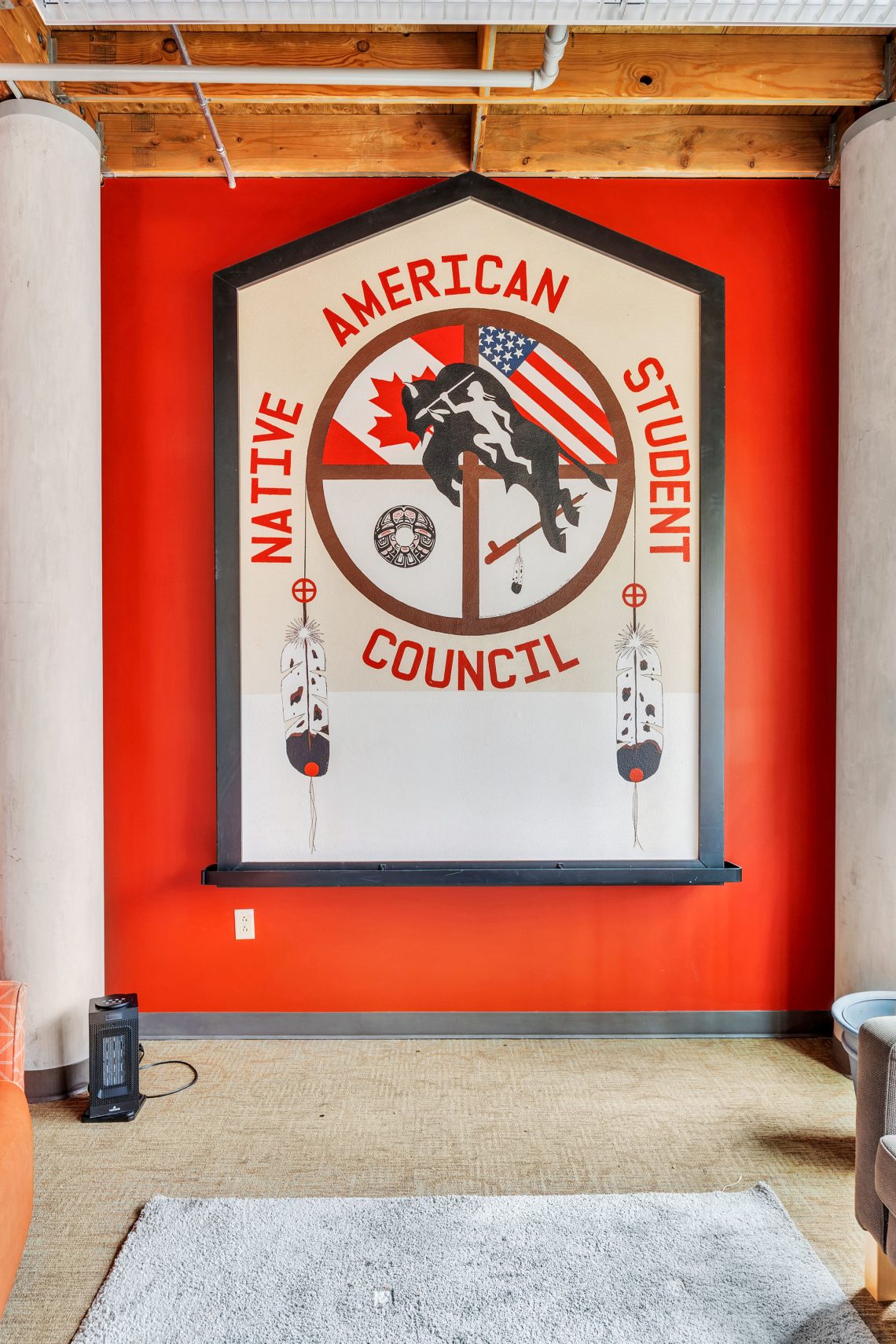Navigation
Black Mural “Bearers of Culture”

Artist: Eddie Walker, Founding member of University of Washington Black Student Union
Date: 1972
Location: Originally created as a wall mural in the Black Room of the original ECC building, this installation has been relocated to the ceiling of our current building
The creation of the murals for the ECC black room was inspired by the spirit, minds, and office labor of Black Women. The women who helped fund the first Black Student Union at the University of Washington. Their efforts were historically unsung, and as minister of art for the B.S.U. I felt it was my duty to leave a visual memorial titled, “Bearers of Culture”.
Many males claimed early B.S.U. leadership positions, but idea administrators needed workers to do the organizing, teaching, phoning, typing, mailing, errands, and cooking. The women of the B.S.U. gave all their labor plus love, spirit, and courage to those radical days of the sixties and early seventies. Their work helped propel the formation of the E.O.P., O.M.A., and E.C.C. complex. All students owe them a debt of gratitude. They help create history with a proved legacy, past, present and future.
It was my honor to donate the talent, paints, and time to leave an image worthy of their sacrifices.
Black Women have helped nurture the dream of freedom in their children, their men, their people, and humanity. May they never aspire to less.
Over twenty years later this mural continues to testify to the unsung heroines of a people, still in search and still fighting for freedom, dignity, and respect.
As an Artist, 20 years older I am proudest of this mural for what it continues to inspire in all who view it. For me and future generations, I hope “Bearers of Culture” inspire others to continue the dreams, continue the sacrifice, and continue the struggle, Black Women Have!
Eddie Walker
Founding member of University of Washington BSU
Asian Mural

Artist: Jesse Reyes
Date: 1985
Location: Originally created as a wall mural in the Asian Room of the original ECC building, this installation has been relocated to the ceiling of our current building
The ASIAN ROOM INSTALLATION is a representation of achievement through adversity, sacrifice and determination. Typical verbiage perhaps, but nonetheless accurate. The visages of ten Asian Americans, known and unknown, of distant and recent times, tell a story if you care to listen. Whether it is the pride in being an AMERICAN, told through the eyes of three anonymous wartime relocation internees, that shows what price was paid to prove loyalty to the American dream. The defiance of Gordon Hirabayashi, unwilling, and rightfully so, to accept being treated a second class citizen by the INJUSTICE OF Executive Order 9066. The community spirit that banded together for the freedom of Chol Soo Lee, wrongly imprisoned for a crime he did not commit. The optimism of Carlos Bulosan, who believed that America was in the heart, and wrote it down for all of us to read- and to remember. The fists of Middleweight Champion of the World Ceferino Garcia, that fought their way out of those migrant fields and cannery rows. The face of a Chinese laborer, upon whose back “Manifest Destiny” was carried and mined and hammered out of the west. “Manifest Destiny” that HE was not allowed to share. The strength of Queen Liliuokalani, of the Hawaiian people by the United States government, in total disregard for THEIR self-like the others, to seek that promise of the “pursuit of happiness”, hopefully without its cruelty. Unfortunately, the murder of Vincent Chin, or the Grand Ledge case, show that there that there is a lot to learn, and much to overcome.
The ASIAN ROOM INSTALLATION is also a protest against the apathy of many young Asians today- no longer interested in community issues or the importance of the strife that came before, and of its significance TODAY. Not some young urban fantasy and a $17,000 starting aid in reminding those young Asians that awareness of our forefathers- and of ourselves- isn’t just the stuff of some 60’s power movement, but a concrete reality that we must deal with every day.
Special thanks to production assistant Michelle Kumata and Steve Chin, Bill Powers, Lino Espinoza and Charlie Canfield and his truck for all their help in putting this all together. Thanks also to the Ethnic Cultural Center, and the Office of Minority Affairs for their support. A very special thanks to Wes Senzaki, whose famous FREEDOM FOR CHOL SOO LEE poster was incorporated into the design, as a crucial testimony of the times.
Jesse Reyes
Chicano Mural “Somos Aztlan”

Artist: Emilio Aguayo
Date: 1972
Location: Originally created as a wall mural in the Chicano Room of the original ECC building, this installation has been relocated to the ceiling of our current building
Somos Aztlan
This Mural embodies the dawning of a new era for all the Spanish-speaking people known as “LA RAZA.” It is a cultural blend of past and present, of Indian heritage, of man struggling alongside woman in the human conflict which is our drive for self-identity and self-determination. This painting is visual testimony that as part of this society, we are part of its past, its present and its future, something which as a people we will not be denied.
We are also a people with ideas in heart, mind, soul and spirit who have lived a history of social oppression, yet… we have hopes for our future.
We are products of mankind – a composite of all races, all colors, yet more the blend of Spaniard and Indian which forms the mestizo precursor of the American Spanish-speaking, here 1—years and more before Columbus. We had a civilization which predated Christ.
Present and past symbols of our cultural history comprise this visual reality of early la raza art. Serpent and sun are symbols worshiped by our ancestors as gods of life and earth. Earth now is symbolic only of the nation within a nation we wish to build. The sun also symbolizes the dawn of our self-awareness, the revolution in the mind we so desperately need. The United Farm Workers flag is symbolic of first manifestations in 1965 of our current social movement. Man and woman symbolize the core of any society, the family unit. In this case, the raza family is what kept us together in adversity.
Society is seen as a four-headed monster of apocalypse, oppression and universal troubles of mankind. It is seen as we see it and live it. Society is thus a personification of oppressive evil now confronted by social change with is good.
Aztlan is an Indian term for the land of the southwest, land of Spanish grants, area of our first beginnings, land of our greatest population concentration in five states.
Colors of this mural represent the five human races and the colors of earth in the southwest
Emilio Aguayo
Native Art Mural “Reflections”

Artist: Michael Lee Beasley, Tlingit
Date: 1985
Location: Originally created as a wall mural in the Native Room of the original ECC building, this installation has been relocated to the ceiling of our current building
Reflections
The Eagle was chosen as the wall theme because Native American and Alaskan students at the University of Washington relate to it – For most Native people the eagle is a symbol of honor.
In developing the design, careful consideration was given to the overall space. An atypical design seemed best suited to the irregular wall space.
The design is a symbolic reflection of students’ time on campus. The great eagle represents a mature development of knowledge, skills and spirit. In the stomach of the larger eagle is an underdeveloped eagle which represents the students upon entering college. As students complete class requirements toward a diploma, they develop. When they complete their education, they are the better for it because they have developed skills and acquired knowledge that they previously might not have had. They are then in turn enabled to help others develop.
Michael Lee Beasley
Tlingit
Other Building Murals
Floor 1

Olin

Pre-Columbian Olin: This design depicts movement or Olin and is from Mexico City (Enciso, Design Motifs, pg. 145, design III). “This simplex glyph, for the place name Olinallan, is a representation of movement (apparently suggestive of both rubber, which jiggles, or earthquakes), called olin.” olin (40r) | Visual Lexicon of Aztec Hieroglyphs (uoregon.edu)
Eagle

Pre-Columbian Eagle (Cuauhtli): This design is inspired by the eagle motif stamps found in Mexico City (Enciso, Design Motifs, Pg. 88). In Aztec history, the eagle was a sacred creature and associated with the god Huitzilopochtli, the god of water, rain, lightning and agriculture. It is said that Huitzilopochtli led the Aztecs to a location where they saw an eagle eating a snake on a cactus, it is here that the Aztecs built their kingdom of Tenochtítlan.
Davis, Isis. “Archaeologists Unearth 600-Year-Old Golden Eagle Sculpture at Aztec Temple.” 2021. Smithsonian Magazine
Floor 2

Fire Serpent

Pre-Columbian Fire Serpent: This design is inspired by a flat stamp found in Mexico depicting the fire serpent. The fire serpent motif represents Xiuhcoatl, the spirit form of Xiuhtecuhtli, the Aztec fire deity (Enciso, Design Motifs, pg. 80).
Floral Group

Pre-Columbian: Floral Group: The Floral Motif shown represents the earth in bloom (Enciso, Design Motifs, pg. 46). This design was inspired by some stamps found in Azcapotzalco, which is located in the Northwestern part of Mexico City.
Chicahuastli

Pre-Columbian Chicahuastli: This Brown figure seems to be the bottom half of a wooden rattle called a Chicahuaxtli. Chicahuastlis originated from the Aztecs and were used in dances to mark the rhythm. The rattle was used as a cane by the Fire God, Xiuhtecuhtli, and other deities associated with water, life and fertility (Enciso, Design Motifs, pg. 142-143).
Aquatic Flowers

Pre-Columbian Aquatic Flowers: Aquatic Flowers is a motif that comes from the State of Mexico (Enciso, Design Motifs, pg 42).
Orange Rooster

Pre-Columbian Orange Rooster: The rooster symbolizes marriage. In some Maya communities proposals are accompanied by the grooms family presenting the potential brides family with between 1 and 3 roosters. https://tramatextiles.org/pages/mayan-symbolism#:~:text=The%20rooster%20is%20associated%20with,prospective%20daughter%2Din%2Dlaw
Oval with Warrior

Pre-Columbian Oval with Warrior: This mural has a few possible interpretations.
- This design is inspired by art stamps of human heads found in Oaxaca. (Enciso, Design Motifs, pg. 129). The warrior depicted also appears to be wearing an animal mask (Enciso, Design Motifs, pg. 126, design I). Masks were incredibly important in pre-columbian times, as they were worn by many different types of people and represented the interconnectedness of the world.
- “The masks alluded to the co-existence of multiple human, natural, and supernatural qualities within the same body, in effect making the mask a medium for creation and revelation as opposed to concealment.”
- “Even the elaborate dress of the warriors incorporated masks. The two principal military orders – the Eagle and Jaguar knights – wore costumes with realistic animal headdresses, representing the animal in whose order they belonged. Their attire probably helped to instill in them the traits of these animals with which they identified and with whom they may have believed they shared a personal soul”.
- “The primary purpose of the pre-Columbian masks was neither to efface or reveal, but to serve as vessels or repositories in which powerful energy was stored”. The Masks Of Mexico (Part 1) – MexConnect
Brown Serpent

Pre-Columbian Brown Serpent: The serpent was a very important social and religious symbol, revered by the Maya. Maya mythology describes serpents as being the vehicles by which celestial bodies, such as the sun and stars, cross the heavens. The shedding of their skin made them a symbol of rebirth and renewal. https://en.wikipedia.org/wiki/Vision_Serpent#:~:text=The%20serpent%20was%20a%20very,symbol%20of%20rebirth%20and%20renewal.
Coatl

Pre-Columbian Coatl: This motif is of a serpent (Coatl). The original design comes from a cylindrical stamp found in Piedras Negras, Veracruz. This design only depicts the serpent’s head and not the rest of its body. (Enciso, Design Motifs, pg. 71)
“Coatl, meaning snake, is the first day of a 13-day period in the Aztec calendar, represented by the image of a stylized snake. It was an auspicious day which the Aztecs regarded to be sacred, and they believed that acting selflessly on this day would bring them the blessings of the gods…The symbol for Coatl is a serpent, which was a sacred creature to the Aztecs. Serpents symbolized Quetzalcoatl, the feathered serpent deity, who was regarded as the god of life, wisdom, day, and winds. Coatl was regarded as a symbol of the earth and also represents Coatlicue, the personification of the earth” Coatl – Aztec Symbol – Symbol Sage.
Orange-Red Bird

Pre-Columbian Orange-Red Bird: Inspired by an Unidentified Bird found in Guerrero (Enciso, design motifs, pg. 96).
Birds in this pre-columbian era, specifically in the Andean societies, were of great importance economically and religiously. Bird feathers were used for trading in the geographic zones of the mountains, coasts, and jungles. The Andean people observed the nature of birds and assigned different roles to the birds based off of tehri behavior and character as they were assigned to the peoples religion. And thus these birds became anthropomorphized symbols. https://rampages.us/pajerowski/2017/03/02/spiritual-imagery-and-materiality-in-pre-columbian-art/
Floor 3

Bearers of Pain

Bearers of Pain: This piece was painting by Eddie Ray Walker (1972) in the previous Ethnic Cultural Center building. Looking at the green, black, and red lines that streak horizontally across the mural, it would appear that this used to be a part of a larger mural including our ‘Bearers of Culture’ mural. It represents “the struggle of the black man in America once he came from Africa”.
Internment Camp

Internment Camps: The Internment Camps were established during WWII, 1942, by President Franklin D. Roosevelt following the attack on Pearl Harbor. The Internment Camps affected roughly 120,000 people with Japanese ancestry, many of whom were American. The Camps continued until 1945 and the last Internment Camp closed March 1946. https://www.history.com/topics/world-war-ii/japanese-american-relocation
Born A Filipino

Born A Filipino: Carlos Bulosan was an author, poet, and activist during his time in the US. Born in Binalonan, Philippines in 1912 and immigrated to America in 1930, Bulosan was faced with much racism and discrimination. He died in Seattle in 1958, leaving behind many poems, short stories, novels, and plays. https://content.lib.washington.edu/exhibits/bulosan/index.html
Asian Power

Asian Power: This mural in modern times can be viewed as problematic without having historical context.
Historical context specifically for this piece:
“It is important to know the history of the effort to ensure that all of the murals from the original ECC structure were retained in the renovated structure and that the decision had input from politically conscious members of each legacy group, as well as their communities. If there was an issue of appropriation at the time, it would have been addressed and resolved.
It is also important to note that during the movement which led to the creation of what is now OMA&D, the BSU ascribed to a third world concept which recognized world wide oppression and supported the struggle and self- determination of people in Africa, Central and South America, Asia, as well as America. So, the proponents of Black Power had no issue with Asians espousing Asian Power. It was considered to be an “us too” expression which was acknowledged. Furthermore, it is important to note that when members of the Asian Coalition for Equality (ACE) demanded that Filipinos and needy Asians be included in the Special Education Program, forerunner to OMA&D, members of the 1969 BSU was present and supported ACE which in turn also supported the efforts of the Black community.”
~Emile Pitre, Senior Advisor to the Vice President of OMA&D, Founding Member of the Black Student Union, and retired Associate Vice President of OMA&D
Research into the Yellow Power Movement:
- “While the Yellow Power Movement was influenced by the Black Power Movement of the 60’s, it did not co op the movement. This mural represents the… It is historically relevant because…” Read more about it in Jeffrey Ogbar’s piece titled, “Yellow Power: The Formation of Asian-American Nationalism in the Age of Black Power, 1966-1975” Yellow Power: The Formation of Asian-American Nationalism in the Age of Black Power, 1966-1975: Souls: Vol 3, No 3 (tandfonline.com)
- Distinct from how these types of movements are thought of today, such as BLM versus All Lives Matter. The sentiment of the 60’s was to encourage solidarity and have accompanying movements for each group. In modern times this is seen as a rebuttal against previously established organizations. Or a reactionary movement
Native American Student Council

Native American Student Council: This mural depicts a part of the original Black Student Union’s (BSU) student organization that was made up of Native American students. Prior to the formation of the Office of Minority Affairs, this student group included people of color from all different backgrounds all working towards a common goal.
Mixtli

Pre-Columbian Mixtli: Depicting a Puma Head (Enciso, Design Motifs, pg. 112, design III). While the art doesn’t look exactly the same there are elements that coincide with each other (teeth, open “mouth”, eye position, only the head being shown, the swirls on each end that curve inwards)
